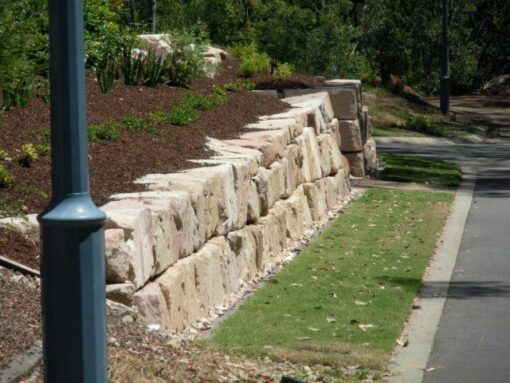The installation of a Stone Retaining Wall Brisbane is becoming increasingly popular amongst homeowners seeking to enhance both the functionality and aesthetics of their properties. Stone retaining walls not only provide essential structural support for managing soil erosion and creating terraced landscapes but also offer a natural beauty that complements the local environment. As Brisbane’s diverse terrain often presents challenges such as sloping properties and heavy rainfall, the choice of a stone retaining wall stands out as an effective solution that marries utility with visual appeal.
The Benefits of Installing a Stone Retaining Wall
Stone retaining walls offer numerous advantages to Brisbane properties. They play a vital role in preventing soil erosion, which is particularly crucial in areas prone to heavy rainfall. By stabilising the soil, these walls help to maintain the integrity of the landscape and reduce the risk of landslides. Additionally, they enable the creation of usable outdoor spaces, transforming otherwise unusable slopes into terraces, gardens, or patios.
The durability of stone retaining walls is another significant benefit. When constructed with quality materials and proper techniques, these structures can last for decades with minimal maintenance, providing long-term value to homeowners. Their inherent strength is capable of withstanding the pressures exerted by surrounding soil and water, ensuring reliable structural support.
Aesthetically, stone retaining walls enhance the visual appeal of any property. Their natural beauty and the variety of available stone types and colours allow for customisation to suit any landscape design. This blend of functionality and visual charm makes stone retaining walls a popular choice for enhancing both the practicality and appearance of outdoor spaces in Brisbane.
Popular Stone Types for Retaining Walls in Brisbane
When choosing materials for a stone retaining wall in Brisbane, several types of stone are favoured for their unique properties. Granite, renowned for its exceptional strength and resistance to weathering, stands out as a top choice. Its diverse range of colours and textures allows it to blend seamlessly with the natural surroundings of Brisbane.
Limestone is another popular option, appreciated for its workability and rustic charm. It offers a natural aesthetic that can enhance the visual appeal of any landscape. Additionally, limestone’s softer composition makes it easier to shape and fit into various designs, providing flexibility in construction.
Sandstone, widely available in the Brisbane region, is celebrated for its warm, earthy tones that create an inviting and harmonious look. Its abundance locally ensures that it is a cost-effective and sustainable choice for many homeowners. Each stone type offers distinct advantages, enabling the selection of materials that best meet the specific design and structural requirements of the retaining wall.
Key Considerations When Planning a Stone Retaining Wall
Planning a stone retaining wall in Brisbane demands attention to several crucial factors to ensure both functionality and aesthetic appeal. An initial site assessment is vital, taking into account the land’s slope, soil type, and potential drainage issues. Proper site evaluation informs the wall’s height, design, and structural requirements. Local regulations play a significant role in the planning process. It is essential to verify with the Brisbane City Council any permits or restrictions applicable to the construction of retaining walls. Compliance with these regulations helps avoid legal complications and ensures the project adheres to safety standards.
The wall’s purpose should be clearly defined, whether it serves a purely functional role or acts as a decorative feature within the landscape. This consideration influences design choices, material selection, and construction techniques. Budgeting is another critical aspect. Costs associated with materials, labour, and additional features, such as landscaping or lighting, must be accounted for. It is advisable to obtain multiple quotes from contractors to compare prices and services offered.
Lastly, considering long-term maintenance requirements is beneficial. Choosing durable materials and proper construction techniques can minimise future upkeep and ensure the wall remains stable and attractive for years to come. By addressing these considerations, homeowners can effectively plan a stone retaining wall that enhances their property’s value and appearance.
Step-By-Step Guide to Building a Stone Retaining Wall
Constructing a stone retaining wall in Brisbane requires meticulous planning and precise execution. The initial stage involves designing and planning, where a detailed layout that includes dimensions and materials is created, ensuring alignment with local regulations. Subsequently, the excavation process begins with clearing the designated area and digging a trench deep enough to provide a robust foundation.
The next step involves preparing the base, typically with a layer of gravel, to facilitate proper drainage and stability, followed by thorough compaction. Stone placement starts at the bottom, with each stone carefully levelled and fitted securely, ensuring minimal gaps. As each layer of stones is placed, backfilling with soil is essential to support the wall and enhance stability.
Once the wall reaches the desired height, the final step is to cap it with flat stones, providing a polished and cohesive finish. These steps, when followed diligently, contribute to the creation of a durable and aesthetically pleasing stone retaining wall that complements the Brisbane landscape.
Hiring Professional Contractors vs. DIY Projects
Hiring professional contractors to build a stone retaining wall in Brisbane offers several distinct advantages. Professionals bring a wealth of experience and expertise, ensuring that the wall is constructed to the highest standards. They are familiar with local regulations and can handle the necessary permits, alleviating potential legal issues. Additionally, contractors have access to high-quality materials and specialised tools that may not be readily available to the average homeowner. Their proficiency in design can result in a retaining wall that not only meets functional requirements but also enhances the aesthetic appeal of the property.
On the other hand, some homeowners may opt for a DIY approach, driven by a desire to save on labour costs or by a passion for hands-on projects. While this can be a cost-effective solution, it is crucial to possess a strong understanding of construction principles and landscape design. A DIY project demands significant time and effort, and mistakes can lead to costly repairs or structural failures.
Therefore, homeowners should carefully evaluate their skill levels, the complexity of the project, and the time they can realistically commit before embarking on a DIY endeavour. Balancing the benefits and challenges of both options will help in making an informed decision that aligns with the specific needs and capabilities of the homeowner.
Maintenance Tips for Long-Lasting Stone Retaining Wall Brisbane
Proper maintenance is essential to ensure the longevity and performance of a Stone Retaining Wall Brisbane. Here are several key maintenance tips:
Regular Inspections
Conduct periodic inspections to identify any signs of damage, such as cracks, loose stones, or signs of shifting. Addressing minor issues promptly can prevent more significant problems down the line.
Weed Control
Weeds can grow in the gaps between stones and their roots may compromise the wall’s stability. Regularly remove any weeds and consider applying a weed barrier or herbicide as necessary.
Drainage Management
Ensure the drainage system remains unobstructed to prevent water accumulation behind the wall. Standing water can exert additional pressure on the structure, potentially leading to failure. Clean out any drainage pipes or weep holes regularly.
Repointing Mortar Joints
If the retaining wall is constructed with mortar, check the joints for any signs of deterioration. Repointing—replacing the old mortar with new—can help maintain the wall’s structural integrity and appearance.
Soil and Vegetation Management
Monitor the soil and vegetation around the wall. Heavy plant growth or excessive soil weight can add undue pressure. Trim back large plants and ensure that the soil grade directs water away from the wall.
Repairing Damage
Address any dislodged or damaged stones immediately. Resetting stones and filling any gaps with appropriate materials can help maintain the wall’s stability and appearance.
Erosion Control
Implement erosion control measures such as mulching or ground cover plants around the wall’s base. These measures can help reduce soil erosion and prevent undermining the wall’s foundation.
Seasonal Care
Pay extra attention during seasonal changes. Heavy rains, for instance, can impact drainage and soil stability. Similarly, dry conditions can lead to soil contraction, affecting the wall’s foundation.
By adhering to these maintenance practices, homeowners can ensure their stone retaining walls remain robust, attractive, and functional for many years.
Inspirational Design Ideas for Stone Retaining Walls
Stone retaining walls in Brisbane can transcend mere functionality, becoming central elements of landscape design. Curved walls that follow the land’s natural contours create a harmonious flow, seamlessly integrating with the environment. Planting pockets can be incorporated within the wall to allow for greenery, adding a touch of softness and a natural feel to the stone’s rugged texture.
Creating multi-tiered retaining walls can transform steep landscapes into beautiful, usable terraces. These levels can be designed to include small gardens, seating areas, or even outdoor kitchens, enhancing both the usability and aesthetic of the space. By using varying stone types and colours, a visually engaging mosaic effect can be achieved, adding depth and interest to the design. Water features are another compelling addition to stone retaining walls. Cascading waterfalls or gentle streams running alongside the wall can infuse a sense of tranquillity and elegance.
Similarly, integrating lighting within the wall structure can dramatically alter its appearance at night, casting subtle shadows and highlighting the wall’s texture. For those seeking a rustic charm, using weathered stones or incorporating reclaimed materials can provide an aged, timeless look. Conversely, sleek, modern designs can be achieved with clean lines and uniform stone placement, offering a contemporary aesthetic. By thoughtfully integrating these elements, stone retaining walls in Brisbane can be both functional and artistically expressive, enhancing the property’s overall landscape and creating inviting outdoor spaces.
Enhancing Property Value with Stone Walls
Stone retaining walls in Brisbane offer more than just structural benefits; they significantly elevate a property’s aesthetic and functional appeal, which can lead to increased property value. Well-designed and expertly constructed stone walls create visually striking landscapes that can captivate potential buyers and investors. Their ability to transform sloped or uneven terrain into functional, attractive outdoor spaces adds practical value, making properties more versatile and appealing.
Additionally, stone retaining walls are often viewed as a hallmark of quality craftsmanship and attention to detail. The use of natural stone materials exudes a sense of permanence and luxury, qualities that are highly sought after in the property market. Prospective buyers are likely to appreciate the reduced maintenance requirements and the long-lasting nature of stone walls, seeing them as a durable investment that reduces future costs.
The customisation options available with stone retaining walls, such as the choice of stone type, colour, and design, allow for unique landscaping features that can set a property apart. Features like integrated seating, planters, or water elements further enhance the outdoor living experience, making the property more desirable.
Conclusion
The integration of Stone Retaining Wall Brisbane properties presents a harmonious blend of function and aesthetics, tailored to meet the unique landscape challenges of the region. With benefits ranging from enhanced soil stability to the creation of appealing outdoor spaces, stone retaining walls serve as a durable and visually striking addition to any property. The selection of materials such as granite, limestone, and sandstone provides flexibility in design, ensuring that these walls not only perform their structural role effectively but also elevate the overall landscape.
FAQs
How much does it cost to build a Stone Retaining Wall Brisbane?
The cost of building a Stone Retaining Wall Brisbane varies significantly based on several factors, including the wall’s size, the type of stone selected, and whether the project is undertaken as a DIY endeavour or contracted out. Homeowners should account for the expenses related to materials, labour, and any supplementary landscaping features when budgeting.
Do local regulations require a permit to build a stone retaining wall in Brisbane?
Obtaining a permit is typically necessary for the construction of a stone retaining wall. It is important to consult the Brisbane City Council for specific regulations and permit requirements to ensure compliance with local laws and avoid any potential legal issues.
What is the expected lifespan of a stone retaining wall?
A stone retaining wall, when built with quality materials and sound construction techniques, can last several decades. Its durability is one of its most significant benefits, offering long-term stability and minimal maintenance.
Is it possible to incorporate flowers or shrubs on top of a stone retaining wall
Yes, planting flowers or shrubs on top of a stone retaining wall is a viable option that can enhance its aesthetic appeal. However, it is crucial to ensure that the wall has proper drainage and sufficient structural integrity to support the additional weight and root systems of the plants.
What are the essential maintenance tasks for a stone retaining wall?
Maintaining a stone retaining wall involves conducting regular inspections to identify and repair any signs of damage, such as cracks or dislodged stones. Weed control is also important to prevent roots from compromising the wall’s stability. Ensuring the drainage system is functioning correctly to manage water flow is vital to preserving the wall’s structural integrity.


